When Vladimir Petkovic was sacked by Lazio president Claudio Lotito after agreeing to take over the Swiss national side the side from Rome turned as so many other Italian sides do to a former coach. Edoardo Reja had initially left Lazio in 2012 after a relatively successful spell in charge and had been replaced by Petkovic. Under both coaches though the criticism from the fans and the media was the same, Lazio lacked a defined tactical identity.
With Reja in charge they were often cautious to a fault playing slow methodical football and failing to take the initiative against teams that would use a low block and compact shape to slow the game down. In part Petkovic was appointed due to his reputation for playing fluid attacking football having set his Young Boys side up in a 3-4-3 system whilst managing in Switzerland. The reality however was somewhat different and Petkovic instituted a strategy that saw Lazio concentrate largely on playing quickly in transitions but still the familiar failings against the low block remained. After Reja left the club for a second time a host of relatively big names were linked to the vacancy, so you can understand the disillusion of the Lazio fans when Stefano Pioli, especially when you consider that Pioli had already experienced failure in his managerial career with spells at the likes of Parma, Sassuolo, Chievo, Palermo and Bologna to name a few.
What the Lazio fans perhaps did not expect was for Pioli to display a level of tactical flexibility and intelligence that belied his managerial career to this point. In terms of systems Pioli started his time with Lazio using almost exclusively a 4-3-3 although at times the attack was left isolated with a lack of a truly dynamic runner from the midfield three. This led to a rethink from Pioli and a switch to a more orthodox 4-2-3-1 with two central players in a double pivot providing the base for the attacking players to exploit. No matter which system was employed though Pioli promoted quick, attacking, fluid football with a front three that had permission to interchange and switch positions to take advantage of space in the attacking third. The central attacking midfielder is given licence to roam across the width and depth of the pitch often dropping deep to link with the two central midfielders and leaving a pocket of space for others to move in to. This exciting attacking system has seen Lazio rise to third in the table with one match remaining. If they can avoid defeat then they will qualify for next seasons Champions League. Let’s break down the system used by Pioli so far this season.
Defensive Phase
In the defensive phase Pioli likes to maintain flexibility by using a medium block and neither committing a large amount of resources forward to press the ball nor leaving space behind the defensive block that the opposition can exploit with direct passes. As much as possible Lazio try to disengage their defensive line from pressuring the ball carrier to maintain their shape. That means that the midfielders in particular have to work a lot harder to press the ball and stop the defensive line from becoming overloaded by midfield runners.
In this example you can see that the Lazio defensive line has positioned themselves at the 18 yard line. In these deep defensive positions it is normal for the central attacking midfielder to drop deep to support the two central midfielders and as you can see there are three Lazio midfielders set up in a narrow defensive shape. The player closest to the ball will apply pressure to the ball carrier to prevent a dangerous pass or shot whilst the central of the three players will look to support him to prevent the Cagliari player beating him in a one on one situation. The far side central midfielder is then free to track any midfield runners that threaten to overload the defensive line.
There are times however when a medium block can be exposed defensively in that the gaps between the midfield and attack of the defence and midfield can be too large and the opposition can overwhelm the defensive structure by using quick direct passes in transition to attack the space.
Here you can see that Chievo have looked to bypass their midfield and used a long diagonal pass to the wide area, the gap between the Lazio defence and the double pivot in midfield is too large and exposed and any Chievo player either dropping in to the space or moving forwards to occupy the space will be in a position to cause a real problem to the Lazio defenders.
Transition
Over the last few years there has been a huge movement amongst both amateur and professional analysts to promote the idea that the transition phase is the key phase in the game. The idea is that when you first lose the ball the opposition player that has recovered possession will be exposed without immediate support for a short pass and that therefore if you apply immediate pressure there is a chance of winning the ball back immediately. At the same time the belief is that should you win the ball back in a deep position from the opposition then the other team should be in the attacking phase and not set in defensive positions. A quick direct pass can often lead to an attacking overload and increase your chances of scoring. Lazio under Pioli are very effective with direct transitions.
Here you can see Lazio attacking in transition in a 4-2-3-1 shape. The ball has just been recovered and the immediate direct pass to the strikers feet is used and the entire opposition midfield is bypassed. By playing an immediate lay off to a supporting player facing the opposition goal the entire width of the field is opened up. Pioli encourages his wide players to attack the gaps in the defensive line looking to force the defensive line backwards and open up more space to to play in the opposition half.
This time Lazio again utilise the direct first pass although this time it is the attacking midfielder in the 4-2-3-1 that has dropped in to a deep position to receive the ball. This piece of movement though has emptied a significant space between the opposition defence and midfield and when the AM drops deep one of the two central midfielders is given licence to move in to more advanced areas. Here you can see that the striker will either look to hold his position or drop in to the space that has been left whilst the two wide attackers attack the spaces in the defensive line.
Attacking Phase
There are two key elements to the attacking play under Pioli, fluidity and support. The midfield setup with a double pivot especially lends itself to lines of support in the attacking movement.
Here you can see that with Cagliari sitting in a low or medium block the double pivot is ideal in terms of maintaining and developing possession of the ball. There are clear passing lanes between the two central midfielders and the three defensive players that are closest to the ball so that the angle and depth of the attacking movement can be changed easily and quickly without fear that the opposition can pressure the ball effectively.
This is an example of Lazio in a sustained attacking phase when the ball has already been recycled backwards at least once and the opposition have set up in a defensive position. In this instance the central striker has found himself in a wide left position and has moved laterally to a central area. This in turn draws the opposition full back in to a more narrow position and opens up space on the left flank. The Lazio full back is able to exploit the space and the fluid attacking movement is completed by the left sided central midfielder who moves left in to a support position both allowing the ball to move backwards easily and making sure that the opposition can’t exploit space in a quick transition.
This fluid movement and close support make it very difficult to defend against Lazio over an extended period as they are extremely adept at creating and exploiting pockets of space in the attacking movement.
Stefano Pioli would almost certainly have not been the first choice amongst Lazio fans to take over from the popular Edoardo Reja but in his first season he has already experienced remarkable success – success that has seen him linked to the Italy national team job should Antonio Conte be lured back to club football. Juventus are without a doubt the strongest team in Italian football at the moment but there is no reason to doubt that Lazio could be in a position to challenge them next season if the board choose to back their coach with a strong recruitment drive over the summer. Stefano Pioli is another example of a coach that has failed in previous jobs but has the game intelligence to learn from his own mistakes and come back a stronger and better prepared coach. The future is bright for Lazio
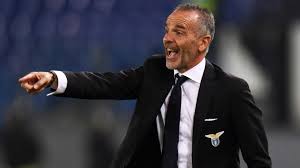
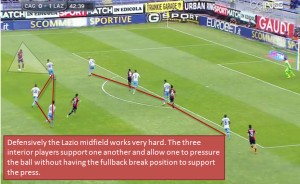
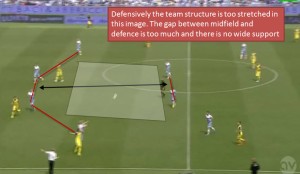

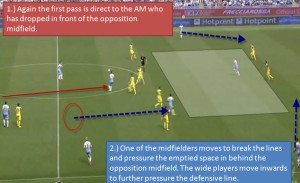

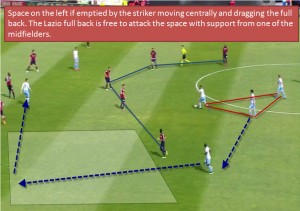
May 28, 2015 @ 19:50:46
Finally ! I like this club since the glorious 90’s/00’s (Nesta and Veron are among my favorite players) and I was desperate that, despite their success this year, nobody seemed interested in Lazio’s excellent season.
Thanks !
May 28, 2015 @ 19:56:24
Nesta was one of my favourite players. I’m glad you enjoyed the article.